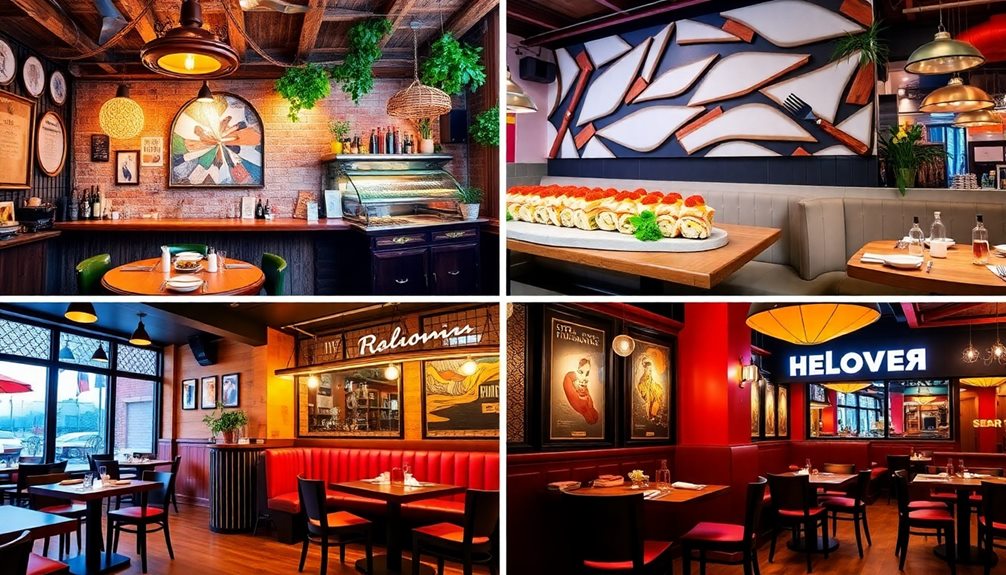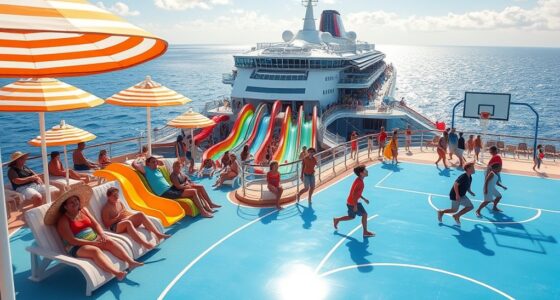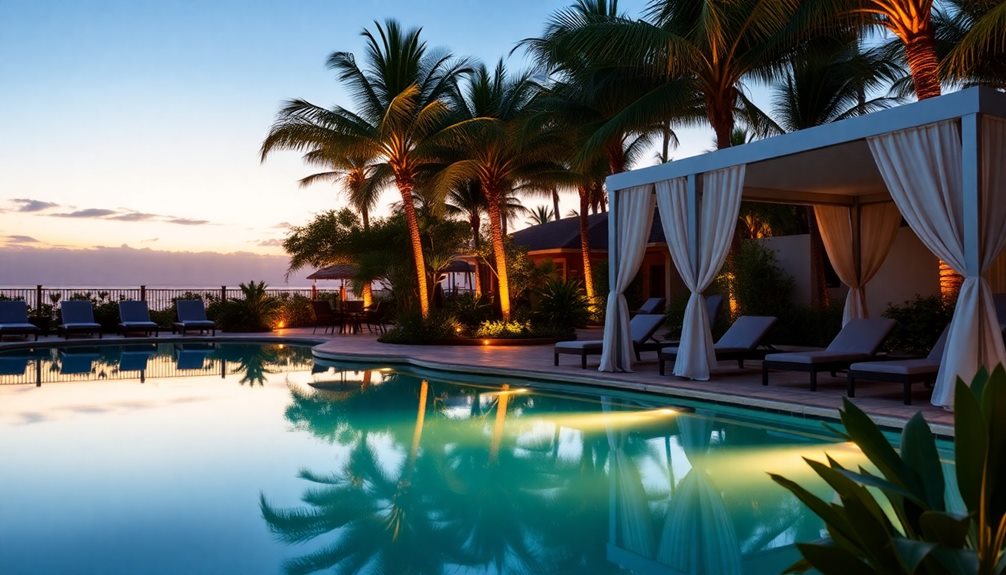When you choose an Alaska cruise, comparing glacier viewing experiences can greatly enhance your journey. Hubbard Glacier impresses with its massive size and dynamic calving events, while Glacier Bay offers a protected sanctuary with rich wildlife and educational insights. Tracy Arm Fjord captivates with its stunning S-turns and waterfalls, and College Fjord showcases elegant tidewater glaciers, perfect for photos. Each location presents unique landscapes and wildlife sightings, creating memorable experiences. By considering the diverse options, you can find the perfect fit for your adventure, and there's much more that could surprise you about these breathtaking glaciers.
Key Takeaways
- Hubbard Glacier offers spectacular calving events and a dynamic experience as it continuously advances, making it a highlight for cruise passengers.
- Glacier Bay features over 1,000 glaciers and provides extensive wildlife sightings and educational insights from park rangers during a 9-10 hour cruise.
- Tracy Arm Fjord presents breathtaking views with cobalt blue icebergs and wildlife sightings, ideal for those seeking adventure and natural beauty.
- College Fjord showcases several tidewater glaciers like Harvard and Yale, offering excellent photo opportunities amidst lush, forested mountains.
- Endicott Arm, home to Dawes Glacier, allows larger ships to navigate floating icebergs, providing unique wildlife encounters and stunning landscapes.
Overview of Glacier Locations

Exploring the stunning glacier locations in Alaska offers travelers unforgettable experiences. One of the highlights is Hubbard Glacier, the largest tidewater glacier in North America, where you can witness impressive calving events.
Glacier Bay, a UNESCO World Heritage Site, features over 1,000 glaciers, including the majestic Margerie and Grand Pacific glaciers. As you sail through, you'll have opportunities for educational engagement with park rangers.
Tracy Arm Fjord is another must-see, showcasing the breathtaking South and North Sawyer glaciers. Here, you can enjoy picturesque waterfalls and frequent wildlife sightings, including seals lounging on ice floes.
If you venture into Prince William Sound, you'll find College Fjord, home to several tidewater glaciers like Harvard and Yale, surrounded by lush, forested mountains.
Many cruise lines that visit these locations offer whale watching excursions, enhancing your Alaskan Dream experience. Each glacier provides unique sights and activities, making your journey through these icy wonders truly memorable.
Whether you're captivated by the dramatic blue icebergs in Tracy Arm or the serene beauty of Glacier Bay, you're sure to cherish every moment.
Hubbard Glacier Experience

Hubbard Glacier captivates visitors with its stunning ice formations and dynamic movement, making it a must-see on any Alaska cruise. As North America's largest tidewater glacier, it stretches an impressive 76 miles and rises 400 feet above water, with an additional 250 feet hidden beneath the surface.
Known as the "galloping glacier," Hubbard has been advancing continuously for over a century, offering a mesmerizing spectacle during your glacier viewing experience.
Cruise ships typically approach within a quarter- to half-mile of the glacier, allowing you to witness spectacular calving events where massive chunks of ice break off and crash into the water. This dramatic display is one of the highlights of your scenic cruising journey.
Located within Wrangell-St. Elias National Park, a UNESCO World Heritage Site, Hubbard Glacier is surrounded by breathtaking natural beauty and ecological significance.
Keep an eye out for wildlife, including seals, whales, and eagles, which enrich your experience with exciting marine life observations. The combination of majestic ice formations and abundant wildlife makes the Hubbard Glacier experience unforgettable, ensuring you'll cherish these memories long after your Alaska cruise ends.
Glacier Bay Highlights

Glacier Bay is a breathtaking 3.3 million-acre protected marine sanctuary that offers a unique opportunity to witness over 1,000 glaciers in one stunning location. As you sail through, you'll see incredible tidewater glaciers, including the iconic Margerie Glacier and the expansive Grand Pacific Glacier. Cruise ships typically spend 9-10 hours in Glacier Bay, covering over 120 miles, providing extensive glacier viewing opportunities.
What's more, National park rangers board the ships to enhance your experience with insightful commentary about the bay's geology and ecology. You won't just see glaciers; you'll also enjoy abundant wildlife sightings. Keep your eyes peeled for seals, sea lions, and even bears along the coastlines, and listen for the distinctive songs of humpback whales.
| Glacier Bay Highlights | Description |
|---|---|
| Tidewater Glaciers | Majestic glaciers calving into the bay |
| Margerie Glacier | Stunning blue ice and dynamic activity |
| Grand Pacific Glacier | Vast, sweeping views of glacier ice |
| Wildlife Sightings | Seals, sea lions, bears, and whales |
| Educational Insights | National park rangers aboard for commentary |
This unique experience makes Glacier Bay a must-see on your cruise adventure!
Unique Features of Other Glaciers

While Glacier Bay is a stunning highlight of Alaskan cruises, there are other remarkable glaciers that offer their own unique experiences.
- Tracy Arm: Navigate through its dramatic narrow fjord filled with deep cobalt blue icebergs. The tight S-turns provide an exhilarating sense of adventure while you soak in breathtaking views of waterfalls and wildlife sightings.
- College Fjord: Here, you'll encounter five tidewater glaciers, including Harvard and Yale. Although it has less wildlife than Glacier Bay, the visually appealing terrain guarantees you'll find incredible photo opportunities amidst the striking glaciers.
- Endicott Arm: This area is home to Dawes Glacier, where larger ships can glide through stunning views of floating icebergs. It's a fantastic spot for wildlife sightings, making your scenic cruising experience truly memorable.
Each of these glacier locations showcases the beauty and diversity of Alaska's icy landscapes.
Whether you're captivated by the adventure of Tracy Arm, the elegance of College Fjord, or the splendor of Endicott Arm, you're bound to create unforgettable memories on your cruise.
Planning Your Glacier Cruise

When you're planning your glacier cruise, it's essential to take into account itineraries that include both Hubbard Glacier and Glacier Bay to guarantee you experience the best of Alaska's icy wonders. Each location offers unique views and features, enhancing your glacier viewing experience.
Midseason cruises, particularly in June and July, are ideal for maximizing visibility and minimizing the chances of ice obstructions or poor weather.
Research specific cruise lines known for exceptional glacier experiences, like Holland America and Princess Cruises. These lines often have onboard naturalists who enrich your journey with insights about the glaciers and wildlife.
You'll want to choose cruises that provide ample time in glacier areas, as Glacier Bay typically offers 9-10 hours of exploration compared to Hubbard Glacier's shorter 4-5 hour viewing window.
Don't forget to take into account shore excursions that boost your glacier adventure. Activities like small boat tours in Tracy Arm allow for closer encounters with tidewater glaciers and local wildlife, enhancing your overall experience.
With careful planning, you can guarantee your Alaska cruises offer unforgettable moments amidst these majestic icy landscapes.
Conclusion
As you commence your Alaskan adventure, remember that each glacier is a unique chapter in a breathtaking story. Whether you're captivated by the majestic Hubbard Glacier or the serene beauty of Glacier Bay, every moment is a chance to connect with nature's artistry. So, as you plan your cruise, keep your heart open to the wonders awaiting you. After all, in the grand tapestry of life, these icy giants remind us of the beauty in change and resilience.
Alfons is the visionary leader and driving force behind Voyager Info’s success. As the Editor in Chief, he brings a wealth of experience and an unwavering passion for travel to the helm of our cruise-centric platform.
With a lifelong fascination for exploring new horizons, Alfons discovered his love for the ocean and cruising at a young age. From sailing across pristine Caribbean waters to embarking on daring expeditions to far-flung destinations, he has amassed a treasure trove of first-hand experiences in the world of cruising.











